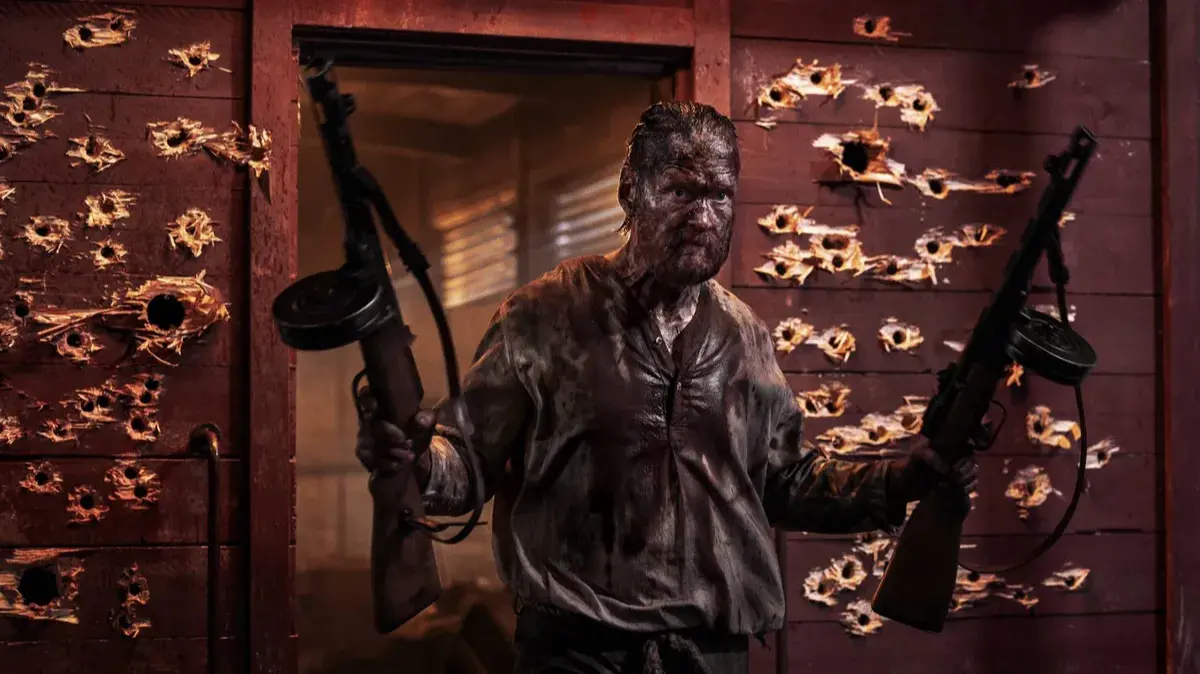Sisu: Road to Revenge ending explained: Does Aatami’s "missile-train kill"end his war?
-
 Aatami Korpi Jorma Tommila steps from a bullet riddled doorway carrying two PPSh 41 drum guns in Sisu: Road to Revenge. Image via Sony pictures.
Aatami Korpi Jorma Tommila steps from a bullet riddled doorway carrying two PPSh 41 drum guns in Sisu: Road to Revenge. Image via Sony pictures.Sisu: Road to Revenge starts in 1946 and follows Aatami Korpi as he tries to move the remains of his family home out of Soviet-occupied Karelia. Jalmari Helander directs. Jorma Tommila returns as Aatami with Stephen Lang as Igor Draganov and Richard Brake in a key supporting role. The sequel to Sisu runs about 89 minutes and opened on November 21, 2025.
It was shot in Estonia and released worldwide through Screen Gems after a Fantastic Fest premiere. The premise is simple. Aatami wants to rebuild what he lost. Draganov wants him erased. The result is a lean road pursuit that ends on a runaway train. Sisu: Road to Revenge keeps the near-silent style and pushes the action scale. That scale matters in the ending, where a missile, a munitions car, and a hurtling locomotive become the final arena.
Sisu: Road to Revenge ending explained: Does Aatami’s "missile-train kill" end his war
The finale begins after Draganov’s men seize Aatami and dump him on a train bound for Siberia. Draganov taunts him about his dead family, which flips the story from survival to revenge. Aatami frees himself, digs out a hidden knife, and moves forward car by car. Draganov hears the fighting and uncouples the rear cars. He kills his own handlers to keep the bounty and speeds ahead. Aatami reaches a munitions car and finds a rocket.
He arms it and rides the thrust to close the gap to Draganov’s locomotive. They fight on the roof while the train screams through the snow. Draganov briefly wins the upper hand. Aatami then detaches the still-burning missile and fires it straight into Draganov. That single choice ends the man who murdered his family and stops the pursuit. He recouples the flatbed carrying the dismantled house and crosses back into Finland without resistance.
The coda is wordless. Locals gather and offer help as Aatami starts to rebuild. Sisu: Road to Revenge clearly answers the headline question. The war that drove him is over for now. The legend remains.
The film seeds the showdown with short, sharp lines rather than long speeches. In the official trailer, Draganov says,
“You are going to be buried in the frozen ground… like the rest of your family.”
The line frames his motive and Aatami’s response. It sets up the rules for the final fight. The fight has no tricks beyond what the audience has already seen. Aatami has grit, tools, and timing. Draganov has reach and rage. The missile provides the speed Aatami lacks. The last image on the border is not the blast. It is a man hauling his house back to where it belongs. Sisu: Road to Revenge keeps that image in focus during the credits.
The road to the train and why the house on a truck matters
Everything before the train wires the emotional charge. Sisu: Road to Revenge opens with Aatami crossing into ceded Karelia and disassembling the house he once shared with his family. He straps the pieces to a truck and points it toward Finland. The KGB frees Draganov because only he might stop the “Immortal.”
The chase begins with a road ambush. Aatami outthinks a squad. A motorbike swarm closes in. A bomber forces the truck and timber into the sea. Aatami refuses to quit. He drags the wood into a working raft and makes it back to shore. He finds a derelict tank. He rigs a crude catapult with dynamite and launches the tank over a border checkpoint. It works at a cost to his body.
Draganov finally captures him and orders torture on the train. In every step, the house drives his choices. It is cargo and motive, and a battleground. When he brings it home at the end, the meaning is earned by the path taken. Along that path, the film drops short threats that build pressure. A handler barks,
“I’m sending you to clean up your mess.”
Draganov growls,
“Unleash hell.”
The effect is to keep the chase moving while telling the audience who is in charge at each beat. These cues also foreshadow the final car-to-car push. Sisu: Road to Revenge stays consistent. It lets action reveal character, and it uses dialogue like a hammer strike.
The ending reads as a pivot from solitary violence to communal repair. Aatami brings his house across the line and accepts help without a word. Sisu: Road to Revenge closes the revenge loop. He has named and ended the man who killed his family. The concept of sisu is grit and refusal to quit.
The coda shows sisu redirected into building rather than killing. That creates a complete character arc inside a very simple plot. It also leaves mythic space around the figure. He is alive. He is still the man who beats impossible odds. He can return if a new threat forces him out of the rebuild.
Stay tuned for more updates.
TOPICS: Sisu: Road to Revenge 2025, Sony